Critical Thinking and Managerial Decision Making
VerifiedAdded on 2022/12/27
|11
|3026
|95
AI Summary
This article discusses the role of critical thinking in managerial decision making and explores various theories and frameworks that influence the decision-making process. It emphasizes the importance of self-awareness, problem-solving techniques, and collaboration in making sound judgments. The article also highlights the impact of psychological factors and the value of innovative conclusions in shaping decisions.
Contribute Materials
Your contribution can guide someone’s learning journey. Share your
documents today.
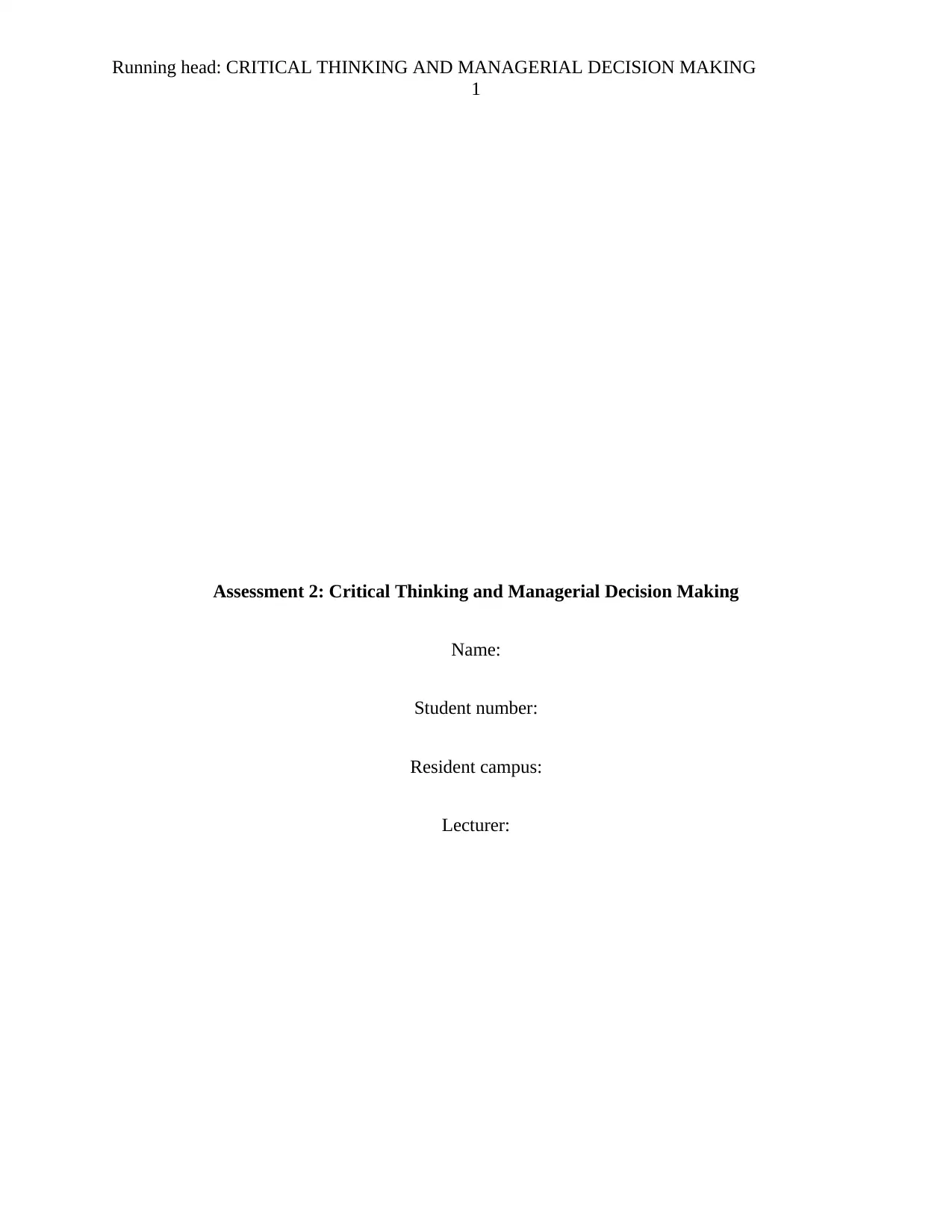
Running head: CRITICAL THINKING AND MANAGERIAL DECISION MAKING
1
Assessment 2: Critical Thinking and Managerial Decision Making
Name:
Student number:
Resident campus:
Lecturer:
1
Assessment 2: Critical Thinking and Managerial Decision Making
Name:
Student number:
Resident campus:
Lecturer:
Secure Best Marks with AI Grader
Need help grading? Try our AI Grader for instant feedback on your assignments.
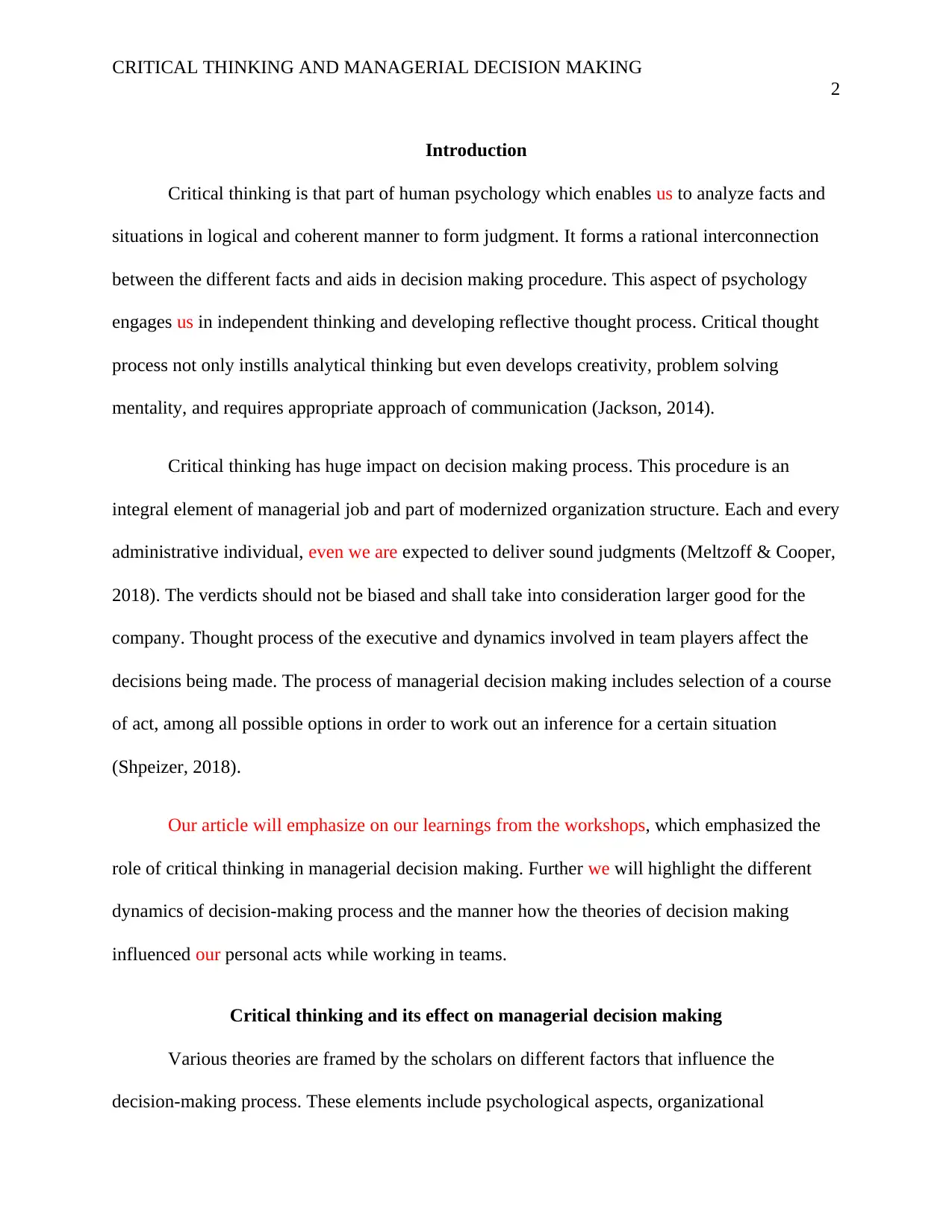
CRITICAL THINKING AND MANAGERIAL DECISION MAKING
2
Introduction
Critical thinking is that part of human psychology which enables us to analyze facts and
situations in logical and coherent manner to form judgment. It forms a rational interconnection
between the different facts and aids in decision making procedure. This aspect of psychology
engages us in independent thinking and developing reflective thought process. Critical thought
process not only instills analytical thinking but even develops creativity, problem solving
mentality, and requires appropriate approach of communication (Jackson, 2014).
Critical thinking has huge impact on decision making process. This procedure is an
integral element of managerial job and part of modernized organization structure. Each and every
administrative individual, even we are expected to deliver sound judgments (Meltzoff & Cooper,
2018). The verdicts should not be biased and shall take into consideration larger good for the
company. Thought process of the executive and dynamics involved in team players affect the
decisions being made. The process of managerial decision making includes selection of a course
of act, among all possible options in order to work out an inference for a certain situation
(Shpeizer, 2018).
Our article will emphasize on our learnings from the workshops, which emphasized the
role of critical thinking in managerial decision making. Further we will highlight the different
dynamics of decision-making process and the manner how the theories of decision making
influenced our personal acts while working in teams.
Critical thinking and its effect on managerial decision making
Various theories are framed by the scholars on different factors that influence the
decision-making process. These elements include psychological aspects, organizational
2
Introduction
Critical thinking is that part of human psychology which enables us to analyze facts and
situations in logical and coherent manner to form judgment. It forms a rational interconnection
between the different facts and aids in decision making procedure. This aspect of psychology
engages us in independent thinking and developing reflective thought process. Critical thought
process not only instills analytical thinking but even develops creativity, problem solving
mentality, and requires appropriate approach of communication (Jackson, 2014).
Critical thinking has huge impact on decision making process. This procedure is an
integral element of managerial job and part of modernized organization structure. Each and every
administrative individual, even we are expected to deliver sound judgments (Meltzoff & Cooper,
2018). The verdicts should not be biased and shall take into consideration larger good for the
company. Thought process of the executive and dynamics involved in team players affect the
decisions being made. The process of managerial decision making includes selection of a course
of act, among all possible options in order to work out an inference for a certain situation
(Shpeizer, 2018).
Our article will emphasize on our learnings from the workshops, which emphasized the
role of critical thinking in managerial decision making. Further we will highlight the different
dynamics of decision-making process and the manner how the theories of decision making
influenced our personal acts while working in teams.
Critical thinking and its effect on managerial decision making
Various theories are framed by the scholars on different factors that influence the
decision-making process. These elements include psychological aspects, organizational
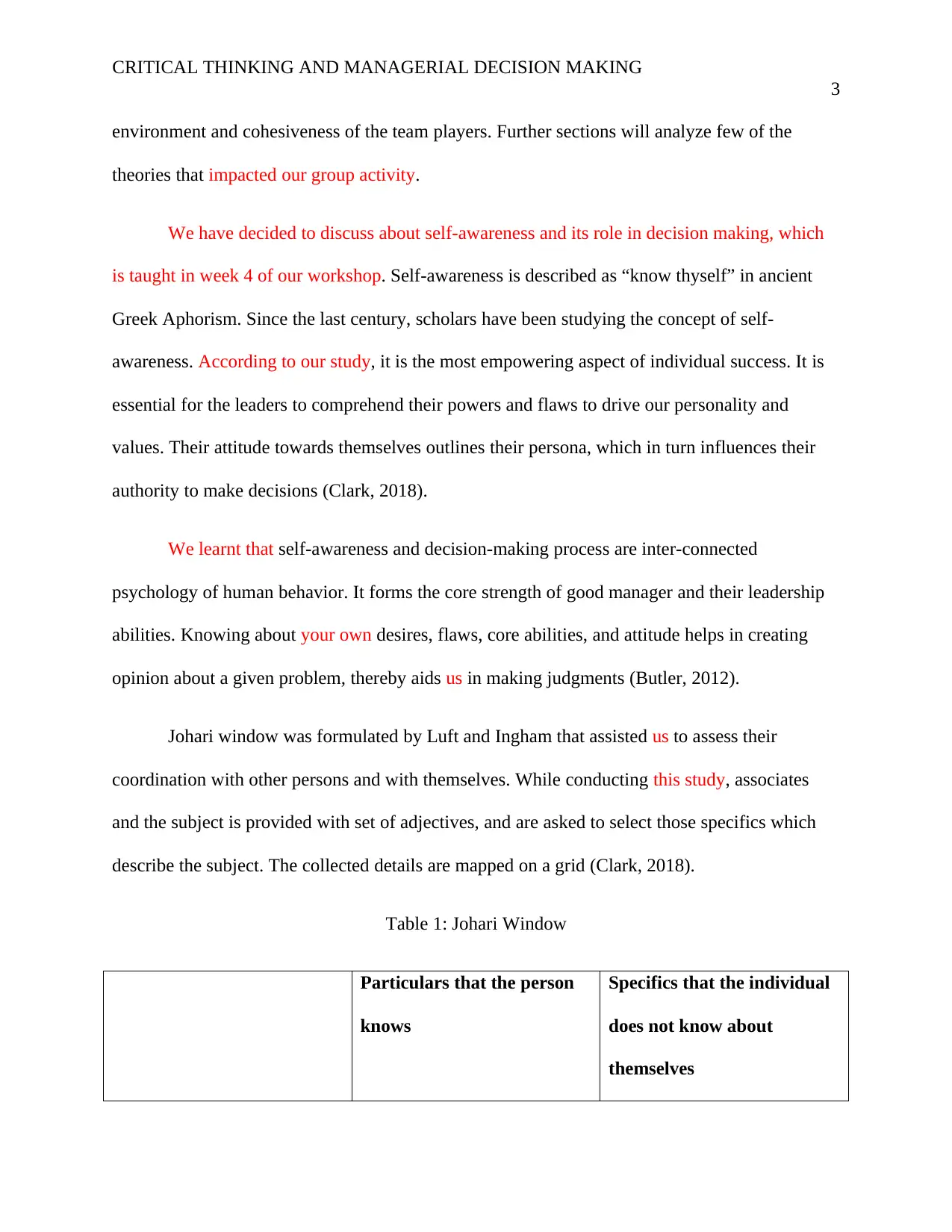
CRITICAL THINKING AND MANAGERIAL DECISION MAKING
3
environment and cohesiveness of the team players. Further sections will analyze few of the
theories that impacted our group activity.
We have decided to discuss about self-awareness and its role in decision making, which
is taught in week 4 of our workshop. Self-awareness is described as “know thyself” in ancient
Greek Aphorism. Since the last century, scholars have been studying the concept of self-
awareness. According to our study, it is the most empowering aspect of individual success. It is
essential for the leaders to comprehend their powers and flaws to drive our personality and
values. Their attitude towards themselves outlines their persona, which in turn influences their
authority to make decisions (Clark, 2018).
We learnt that self-awareness and decision-making process are inter-connected
psychology of human behavior. It forms the core strength of good manager and their leadership
abilities. Knowing about your own desires, flaws, core abilities, and attitude helps in creating
opinion about a given problem, thereby aids us in making judgments (Butler, 2012).
Johari window was formulated by Luft and Ingham that assisted us to assess their
coordination with other persons and with themselves. While conducting this study, associates
and the subject is provided with set of adjectives, and are asked to select those specifics which
describe the subject. The collected details are mapped on a grid (Clark, 2018).
Table 1: Johari Window
Particulars that the person
knows
Specifics that the individual
does not know about
themselves
3
environment and cohesiveness of the team players. Further sections will analyze few of the
theories that impacted our group activity.
We have decided to discuss about self-awareness and its role in decision making, which
is taught in week 4 of our workshop. Self-awareness is described as “know thyself” in ancient
Greek Aphorism. Since the last century, scholars have been studying the concept of self-
awareness. According to our study, it is the most empowering aspect of individual success. It is
essential for the leaders to comprehend their powers and flaws to drive our personality and
values. Their attitude towards themselves outlines their persona, which in turn influences their
authority to make decisions (Clark, 2018).
We learnt that self-awareness and decision-making process are inter-connected
psychology of human behavior. It forms the core strength of good manager and their leadership
abilities. Knowing about your own desires, flaws, core abilities, and attitude helps in creating
opinion about a given problem, thereby aids us in making judgments (Butler, 2012).
Johari window was formulated by Luft and Ingham that assisted us to assess their
coordination with other persons and with themselves. While conducting this study, associates
and the subject is provided with set of adjectives, and are asked to select those specifics which
describe the subject. The collected details are mapped on a grid (Clark, 2018).
Table 1: Johari Window
Particulars that the person
knows
Specifics that the individual
does not know about
themselves
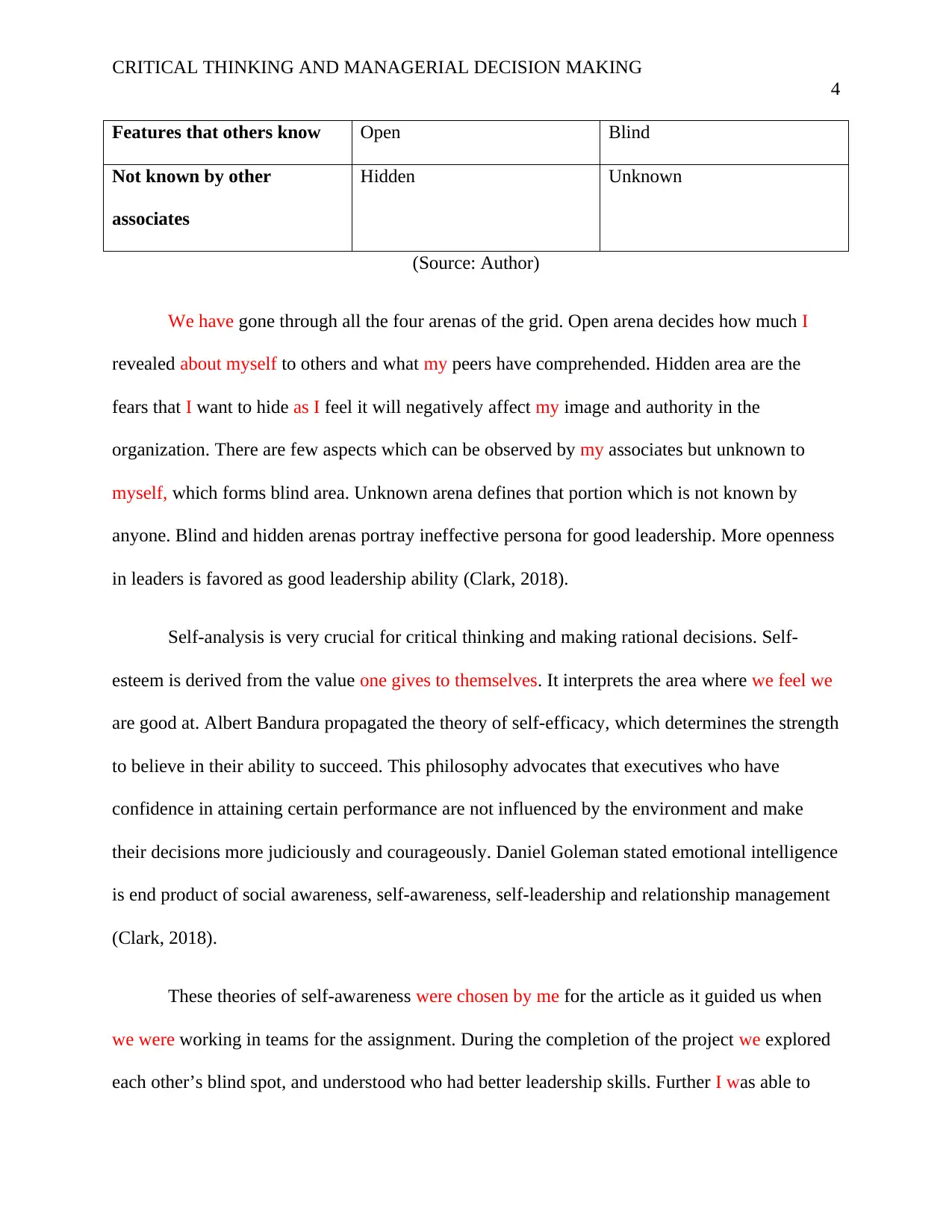
CRITICAL THINKING AND MANAGERIAL DECISION MAKING
4
Features that others know Open Blind
Not known by other
associates
Hidden Unknown
(Source: Author)
We have gone through all the four arenas of the grid. Open arena decides how much I
revealed about myself to others and what my peers have comprehended. Hidden area are the
fears that I want to hide as I feel it will negatively affect my image and authority in the
organization. There are few aspects which can be observed by my associates but unknown to
myself, which forms blind area. Unknown arena defines that portion which is not known by
anyone. Blind and hidden arenas portray ineffective persona for good leadership. More openness
in leaders is favored as good leadership ability (Clark, 2018).
Self-analysis is very crucial for critical thinking and making rational decisions. Self-
esteem is derived from the value one gives to themselves. It interprets the area where we feel we
are good at. Albert Bandura propagated the theory of self-efficacy, which determines the strength
to believe in their ability to succeed. This philosophy advocates that executives who have
confidence in attaining certain performance are not influenced by the environment and make
their decisions more judiciously and courageously. Daniel Goleman stated emotional intelligence
is end product of social awareness, self-awareness, self-leadership and relationship management
(Clark, 2018).
These theories of self-awareness were chosen by me for the article as it guided us when
we were working in teams for the assignment. During the completion of the project we explored
each other’s blind spot, and understood who had better leadership skills. Further I was able to
4
Features that others know Open Blind
Not known by other
associates
Hidden Unknown
(Source: Author)
We have gone through all the four arenas of the grid. Open arena decides how much I
revealed about myself to others and what my peers have comprehended. Hidden area are the
fears that I want to hide as I feel it will negatively affect my image and authority in the
organization. There are few aspects which can be observed by my associates but unknown to
myself, which forms blind area. Unknown arena defines that portion which is not known by
anyone. Blind and hidden arenas portray ineffective persona for good leadership. More openness
in leaders is favored as good leadership ability (Clark, 2018).
Self-analysis is very crucial for critical thinking and making rational decisions. Self-
esteem is derived from the value one gives to themselves. It interprets the area where we feel we
are good at. Albert Bandura propagated the theory of self-efficacy, which determines the strength
to believe in their ability to succeed. This philosophy advocates that executives who have
confidence in attaining certain performance are not influenced by the environment and make
their decisions more judiciously and courageously. Daniel Goleman stated emotional intelligence
is end product of social awareness, self-awareness, self-leadership and relationship management
(Clark, 2018).
These theories of self-awareness were chosen by me for the article as it guided us when
we were working in teams for the assignment. During the completion of the project we explored
each other’s blind spot, and understood who had better leadership skills. Further I was able to
Secure Best Marks with AI Grader
Need help grading? Try our AI Grader for instant feedback on your assignments.
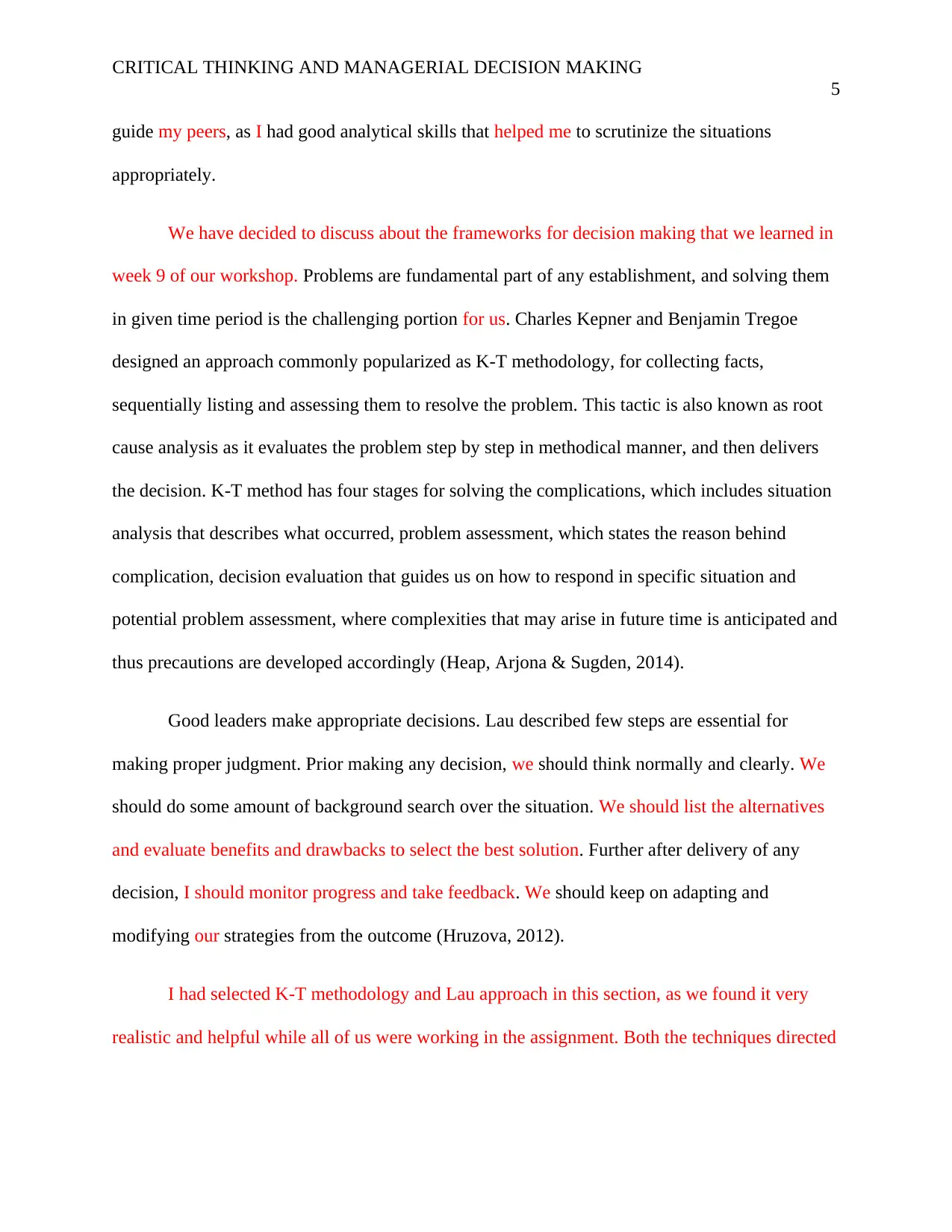
CRITICAL THINKING AND MANAGERIAL DECISION MAKING
5
guide my peers, as I had good analytical skills that helped me to scrutinize the situations
appropriately.
We have decided to discuss about the frameworks for decision making that we learned in
week 9 of our workshop. Problems are fundamental part of any establishment, and solving them
in given time period is the challenging portion for us. Charles Kepner and Benjamin Tregoe
designed an approach commonly popularized as K-T methodology, for collecting facts,
sequentially listing and assessing them to resolve the problem. This tactic is also known as root
cause analysis as it evaluates the problem step by step in methodical manner, and then delivers
the decision. K-T method has four stages for solving the complications, which includes situation
analysis that describes what occurred, problem assessment, which states the reason behind
complication, decision evaluation that guides us on how to respond in specific situation and
potential problem assessment, where complexities that may arise in future time is anticipated and
thus precautions are developed accordingly (Heap, Arjona & Sugden, 2014).
Good leaders make appropriate decisions. Lau described few steps are essential for
making proper judgment. Prior making any decision, we should think normally and clearly. We
should do some amount of background search over the situation. We should list the alternatives
and evaluate benefits and drawbacks to select the best solution. Further after delivery of any
decision, I should monitor progress and take feedback. We should keep on adapting and
modifying our strategies from the outcome (Hruzova, 2012).
I had selected K-T methodology and Lau approach in this section, as we found it very
realistic and helpful while all of us were working in the assignment. Both the techniques directed
5
guide my peers, as I had good analytical skills that helped me to scrutinize the situations
appropriately.
We have decided to discuss about the frameworks for decision making that we learned in
week 9 of our workshop. Problems are fundamental part of any establishment, and solving them
in given time period is the challenging portion for us. Charles Kepner and Benjamin Tregoe
designed an approach commonly popularized as K-T methodology, for collecting facts,
sequentially listing and assessing them to resolve the problem. This tactic is also known as root
cause analysis as it evaluates the problem step by step in methodical manner, and then delivers
the decision. K-T method has four stages for solving the complications, which includes situation
analysis that describes what occurred, problem assessment, which states the reason behind
complication, decision evaluation that guides us on how to respond in specific situation and
potential problem assessment, where complexities that may arise in future time is anticipated and
thus precautions are developed accordingly (Heap, Arjona & Sugden, 2014).
Good leaders make appropriate decisions. Lau described few steps are essential for
making proper judgment. Prior making any decision, we should think normally and clearly. We
should do some amount of background search over the situation. We should list the alternatives
and evaluate benefits and drawbacks to select the best solution. Further after delivery of any
decision, I should monitor progress and take feedback. We should keep on adapting and
modifying our strategies from the outcome (Hruzova, 2012).
I had selected K-T methodology and Lau approach in this section, as we found it very
realistic and helpful while all of us were working in the assignment. Both the techniques directed
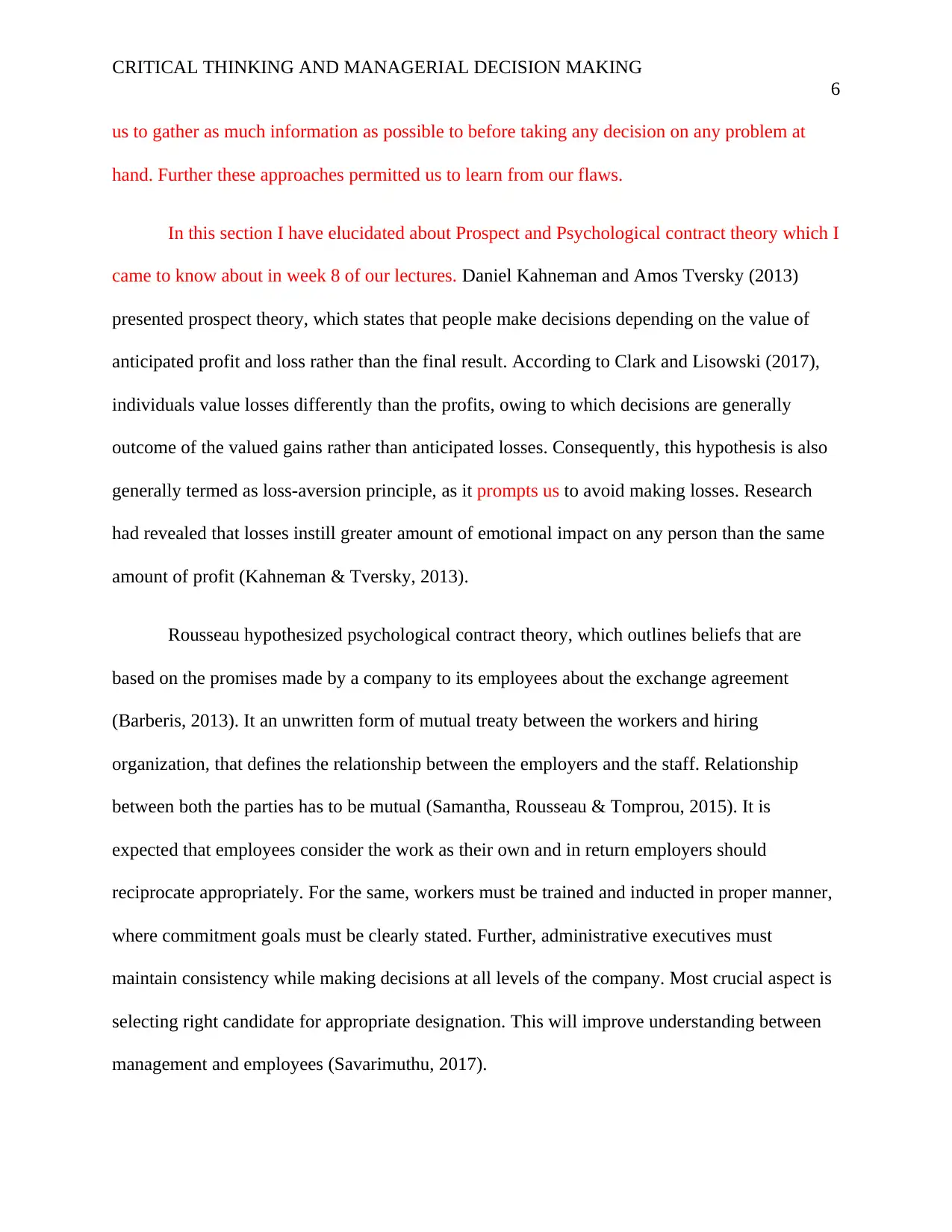
CRITICAL THINKING AND MANAGERIAL DECISION MAKING
6
us to gather as much information as possible to before taking any decision on any problem at
hand. Further these approaches permitted us to learn from our flaws.
In this section I have elucidated about Prospect and Psychological contract theory which I
came to know about in week 8 of our lectures. Daniel Kahneman and Amos Tversky (2013)
presented prospect theory, which states that people make decisions depending on the value of
anticipated profit and loss rather than the final result. According to Clark and Lisowski (2017),
individuals value losses differently than the profits, owing to which decisions are generally
outcome of the valued gains rather than anticipated losses. Consequently, this hypothesis is also
generally termed as loss-aversion principle, as it prompts us to avoid making losses. Research
had revealed that losses instill greater amount of emotional impact on any person than the same
amount of profit (Kahneman & Tversky, 2013).
Rousseau hypothesized psychological contract theory, which outlines beliefs that are
based on the promises made by a company to its employees about the exchange agreement
(Barberis, 2013). It an unwritten form of mutual treaty between the workers and hiring
organization, that defines the relationship between the employers and the staff. Relationship
between both the parties has to be mutual (Samantha, Rousseau & Tomprou, 2015). It is
expected that employees consider the work as their own and in return employers should
reciprocate appropriately. For the same, workers must be trained and inducted in proper manner,
where commitment goals must be clearly stated. Further, administrative executives must
maintain consistency while making decisions at all levels of the company. Most crucial aspect is
selecting right candidate for appropriate designation. This will improve understanding between
management and employees (Savarimuthu, 2017).
6
us to gather as much information as possible to before taking any decision on any problem at
hand. Further these approaches permitted us to learn from our flaws.
In this section I have elucidated about Prospect and Psychological contract theory which I
came to know about in week 8 of our lectures. Daniel Kahneman and Amos Tversky (2013)
presented prospect theory, which states that people make decisions depending on the value of
anticipated profit and loss rather than the final result. According to Clark and Lisowski (2017),
individuals value losses differently than the profits, owing to which decisions are generally
outcome of the valued gains rather than anticipated losses. Consequently, this hypothesis is also
generally termed as loss-aversion principle, as it prompts us to avoid making losses. Research
had revealed that losses instill greater amount of emotional impact on any person than the same
amount of profit (Kahneman & Tversky, 2013).
Rousseau hypothesized psychological contract theory, which outlines beliefs that are
based on the promises made by a company to its employees about the exchange agreement
(Barberis, 2013). It an unwritten form of mutual treaty between the workers and hiring
organization, that defines the relationship between the employers and the staff. Relationship
between both the parties has to be mutual (Samantha, Rousseau & Tomprou, 2015). It is
expected that employees consider the work as their own and in return employers should
reciprocate appropriately. For the same, workers must be trained and inducted in proper manner,
where commitment goals must be clearly stated. Further, administrative executives must
maintain consistency while making decisions at all levels of the company. Most crucial aspect is
selecting right candidate for appropriate designation. This will improve understanding between
management and employees (Savarimuthu, 2017).
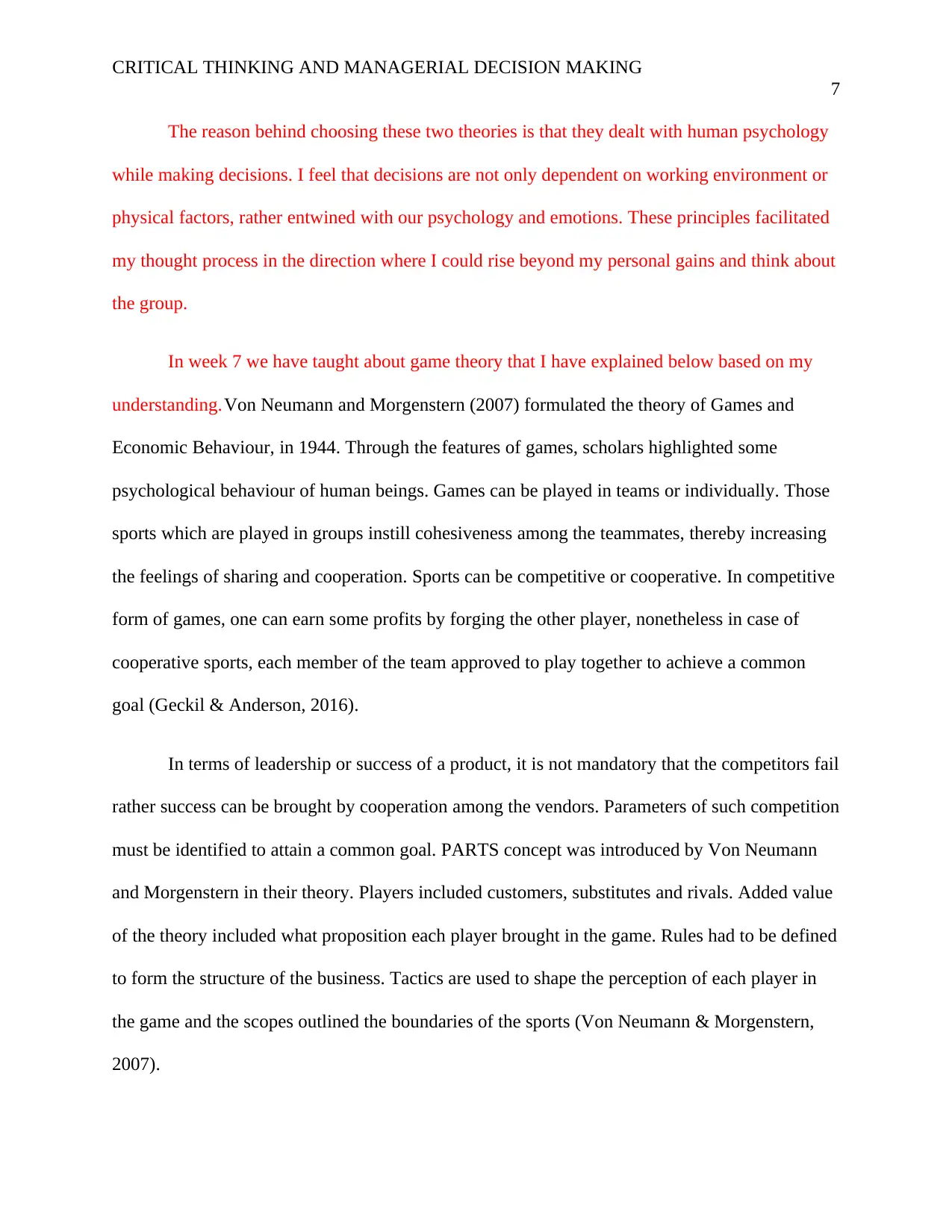
CRITICAL THINKING AND MANAGERIAL DECISION MAKING
7
The reason behind choosing these two theories is that they dealt with human psychology
while making decisions. I feel that decisions are not only dependent on working environment or
physical factors, rather entwined with our psychology and emotions. These principles facilitated
my thought process in the direction where I could rise beyond my personal gains and think about
the group.
In week 7 we have taught about game theory that I have explained below based on my
understanding.Von Neumann and Morgenstern (2007) formulated the theory of Games and
Economic Behaviour, in 1944. Through the features of games, scholars highlighted some
psychological behaviour of human beings. Games can be played in teams or individually. Those
sports which are played in groups instill cohesiveness among the teammates, thereby increasing
the feelings of sharing and cooperation. Sports can be competitive or cooperative. In competitive
form of games, one can earn some profits by forging the other player, nonetheless in case of
cooperative sports, each member of the team approved to play together to achieve a common
goal (Geckil & Anderson, 2016).
In terms of leadership or success of a product, it is not mandatory that the competitors fail
rather success can be brought by cooperation among the vendors. Parameters of such competition
must be identified to attain a common goal. PARTS concept was introduced by Von Neumann
and Morgenstern in their theory. Players included customers, substitutes and rivals. Added value
of the theory included what proposition each player brought in the game. Rules had to be defined
to form the structure of the business. Tactics are used to shape the perception of each player in
the game and the scopes outlined the boundaries of the sports (Von Neumann & Morgenstern,
2007).
7
The reason behind choosing these two theories is that they dealt with human psychology
while making decisions. I feel that decisions are not only dependent on working environment or
physical factors, rather entwined with our psychology and emotions. These principles facilitated
my thought process in the direction where I could rise beyond my personal gains and think about
the group.
In week 7 we have taught about game theory that I have explained below based on my
understanding.Von Neumann and Morgenstern (2007) formulated the theory of Games and
Economic Behaviour, in 1944. Through the features of games, scholars highlighted some
psychological behaviour of human beings. Games can be played in teams or individually. Those
sports which are played in groups instill cohesiveness among the teammates, thereby increasing
the feelings of sharing and cooperation. Sports can be competitive or cooperative. In competitive
form of games, one can earn some profits by forging the other player, nonetheless in case of
cooperative sports, each member of the team approved to play together to achieve a common
goal (Geckil & Anderson, 2016).
In terms of leadership or success of a product, it is not mandatory that the competitors fail
rather success can be brought by cooperation among the vendors. Parameters of such competition
must be identified to attain a common goal. PARTS concept was introduced by Von Neumann
and Morgenstern in their theory. Players included customers, substitutes and rivals. Added value
of the theory included what proposition each player brought in the game. Rules had to be defined
to form the structure of the business. Tactics are used to shape the perception of each player in
the game and the scopes outlined the boundaries of the sports (Von Neumann & Morgenstern,
2007).
Paraphrase This Document
Need a fresh take? Get an instant paraphrase of this document with our AI Paraphraser
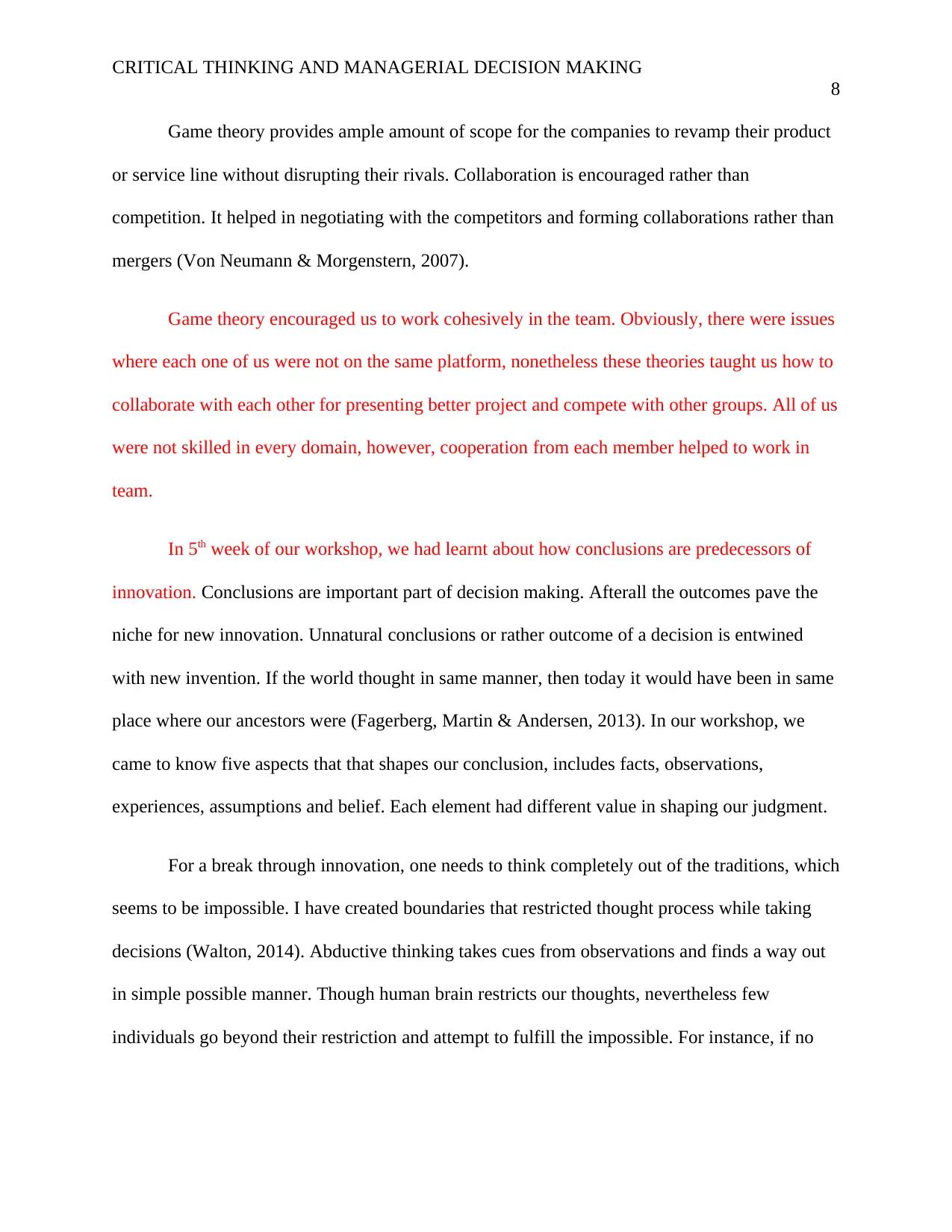
CRITICAL THINKING AND MANAGERIAL DECISION MAKING
8
Game theory provides ample amount of scope for the companies to revamp their product
or service line without disrupting their rivals. Collaboration is encouraged rather than
competition. It helped in negotiating with the competitors and forming collaborations rather than
mergers (Von Neumann & Morgenstern, 2007).
Game theory encouraged us to work cohesively in the team. Obviously, there were issues
where each one of us were not on the same platform, nonetheless these theories taught us how to
collaborate with each other for presenting better project and compete with other groups. All of us
were not skilled in every domain, however, cooperation from each member helped to work in
team.
In 5th week of our workshop, we had learnt about how conclusions are predecessors of
innovation. Conclusions are important part of decision making. Afterall the outcomes pave the
niche for new innovation. Unnatural conclusions or rather outcome of a decision is entwined
with new invention. If the world thought in same manner, then today it would have been in same
place where our ancestors were (Fagerberg, Martin & Andersen, 2013). In our workshop, we
came to know five aspects that that shapes our conclusion, includes facts, observations,
experiences, assumptions and belief. Each element had different value in shaping our judgment.
For a break through innovation, one needs to think completely out of the traditions, which
seems to be impossible. I have created boundaries that restricted thought process while taking
decisions (Walton, 2014). Abductive thinking takes cues from observations and finds a way out
in simple possible manner. Though human brain restricts our thoughts, nevertheless few
individuals go beyond their restriction and attempt to fulfill the impossible. For instance, if no
8
Game theory provides ample amount of scope for the companies to revamp their product
or service line without disrupting their rivals. Collaboration is encouraged rather than
competition. It helped in negotiating with the competitors and forming collaborations rather than
mergers (Von Neumann & Morgenstern, 2007).
Game theory encouraged us to work cohesively in the team. Obviously, there were issues
where each one of us were not on the same platform, nonetheless these theories taught us how to
collaborate with each other for presenting better project and compete with other groups. All of us
were not skilled in every domain, however, cooperation from each member helped to work in
team.
In 5th week of our workshop, we had learnt about how conclusions are predecessors of
innovation. Conclusions are important part of decision making. Afterall the outcomes pave the
niche for new innovation. Unnatural conclusions or rather outcome of a decision is entwined
with new invention. If the world thought in same manner, then today it would have been in same
place where our ancestors were (Fagerberg, Martin & Andersen, 2013). In our workshop, we
came to know five aspects that that shapes our conclusion, includes facts, observations,
experiences, assumptions and belief. Each element had different value in shaping our judgment.
For a break through innovation, one needs to think completely out of the traditions, which
seems to be impossible. I have created boundaries that restricted thought process while taking
decisions (Walton, 2014). Abductive thinking takes cues from observations and finds a way out
in simple possible manner. Though human brain restricts our thoughts, nevertheless few
individuals go beyond their restriction and attempt to fulfill the impossible. For instance, if no
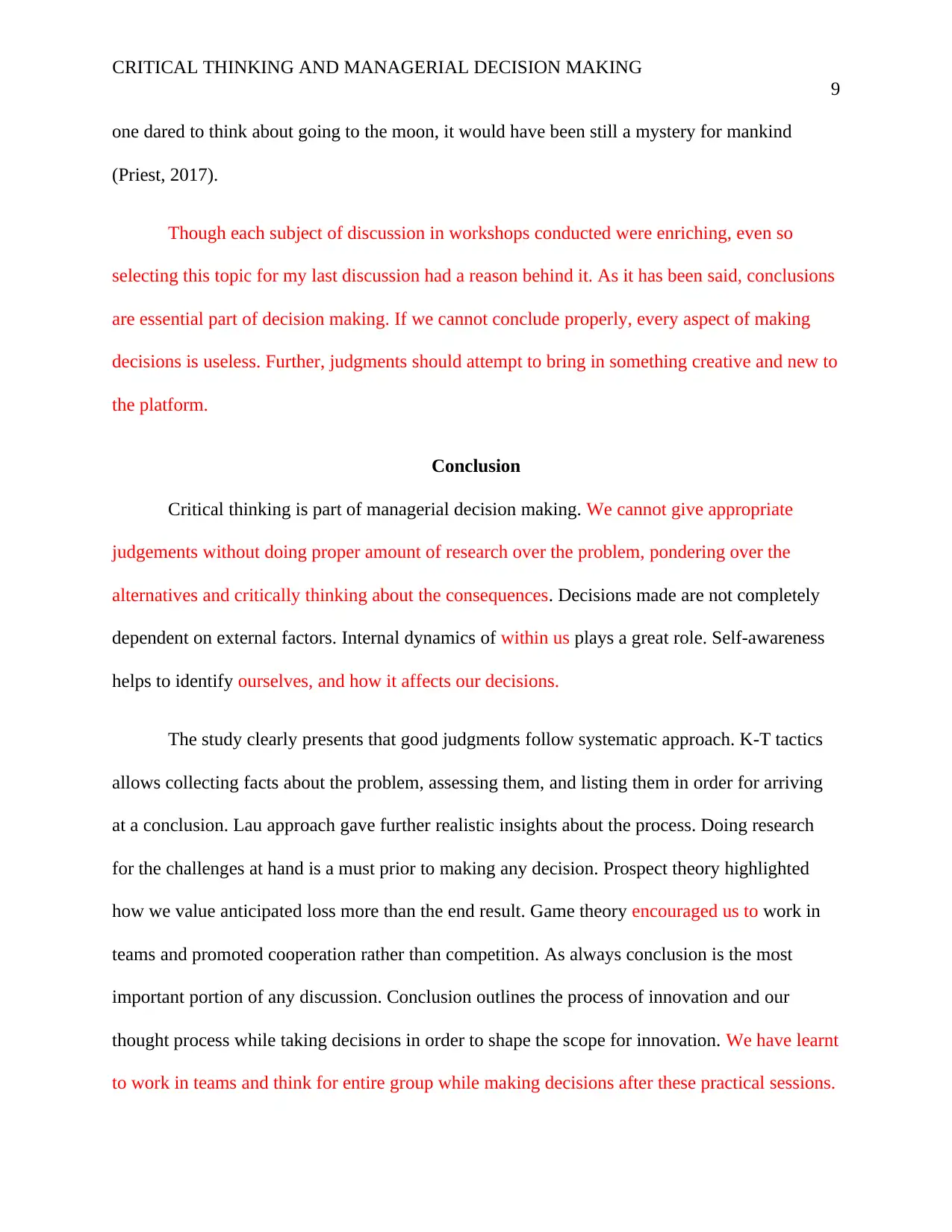
CRITICAL THINKING AND MANAGERIAL DECISION MAKING
9
one dared to think about going to the moon, it would have been still a mystery for mankind
(Priest, 2017).
Though each subject of discussion in workshops conducted were enriching, even so
selecting this topic for my last discussion had a reason behind it. As it has been said, conclusions
are essential part of decision making. If we cannot conclude properly, every aspect of making
decisions is useless. Further, judgments should attempt to bring in something creative and new to
the platform.
Conclusion
Critical thinking is part of managerial decision making. We cannot give appropriate
judgements without doing proper amount of research over the problem, pondering over the
alternatives and critically thinking about the consequences. Decisions made are not completely
dependent on external factors. Internal dynamics of within us plays a great role. Self-awareness
helps to identify ourselves, and how it affects our decisions.
The study clearly presents that good judgments follow systematic approach. K-T tactics
allows collecting facts about the problem, assessing them, and listing them in order for arriving
at a conclusion. Lau approach gave further realistic insights about the process. Doing research
for the challenges at hand is a must prior to making any decision. Prospect theory highlighted
how we value anticipated loss more than the end result. Game theory encouraged us to work in
teams and promoted cooperation rather than competition. As always conclusion is the most
important portion of any discussion. Conclusion outlines the process of innovation and our
thought process while taking decisions in order to shape the scope for innovation. We have learnt
to work in teams and think for entire group while making decisions after these practical sessions.
9
one dared to think about going to the moon, it would have been still a mystery for mankind
(Priest, 2017).
Though each subject of discussion in workshops conducted were enriching, even so
selecting this topic for my last discussion had a reason behind it. As it has been said, conclusions
are essential part of decision making. If we cannot conclude properly, every aspect of making
decisions is useless. Further, judgments should attempt to bring in something creative and new to
the platform.
Conclusion
Critical thinking is part of managerial decision making. We cannot give appropriate
judgements without doing proper amount of research over the problem, pondering over the
alternatives and critically thinking about the consequences. Decisions made are not completely
dependent on external factors. Internal dynamics of within us plays a great role. Self-awareness
helps to identify ourselves, and how it affects our decisions.
The study clearly presents that good judgments follow systematic approach. K-T tactics
allows collecting facts about the problem, assessing them, and listing them in order for arriving
at a conclusion. Lau approach gave further realistic insights about the process. Doing research
for the challenges at hand is a must prior to making any decision. Prospect theory highlighted
how we value anticipated loss more than the end result. Game theory encouraged us to work in
teams and promoted cooperation rather than competition. As always conclusion is the most
important portion of any discussion. Conclusion outlines the process of innovation and our
thought process while taking decisions in order to shape the scope for innovation. We have learnt
to work in teams and think for entire group while making decisions after these practical sessions.
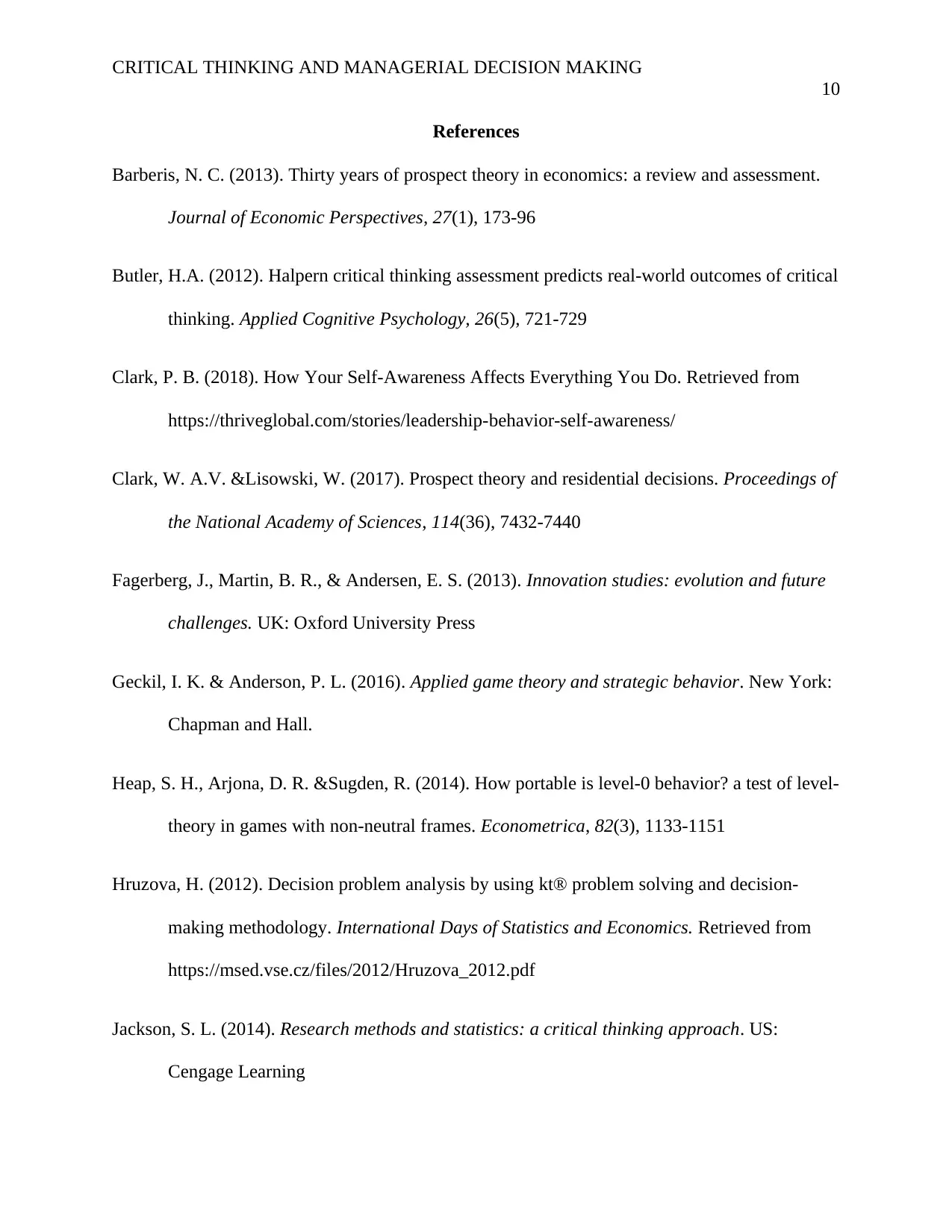
CRITICAL THINKING AND MANAGERIAL DECISION MAKING
10
References
Barberis, N. C. (2013). Thirty years of prospect theory in economics: a review and assessment.
Journal of Economic Perspectives, 27(1), 173-96
Butler, H.A. (2012). Halpern critical thinking assessment predicts real‐world outcomes of critical
thinking. Applied Cognitive Psychology, 26(5), 721-729
Clark, P. B. (2018). How Your Self-Awareness Affects Everything You Do. Retrieved from
https://thriveglobal.com/stories/leadership-behavior-self-awareness/
Clark, W. A.V. &Lisowski, W. (2017). Prospect theory and residential decisions. Proceedings of
the National Academy of Sciences, 114(36), 7432-7440
Fagerberg, J., Martin, B. R., & Andersen, E. S. (2013). Innovation studies: evolution and future
challenges. UK: Oxford University Press
Geckil, I. K. & Anderson, P. L. (2016). Applied game theory and strategic behavior. New York:
Chapman and Hall.
Heap, S. H., Arjona, D. R. &Sugden, R. (2014). How portable is level‐0 behavior? a test of level-
theory in games with non-neutral frames. Econometrica, 82(3), 1133-1151
Hruzova, H. (2012). Decision problem analysis by using kt® problem solving and decision-
making methodology. International Days of Statistics and Economics. Retrieved from
https://msed.vse.cz/files/2012/Hruzova_2012.pdf
Jackson, S. L. (2014). Research methods and statistics: a critical thinking approach. US:
Cengage Learning
10
References
Barberis, N. C. (2013). Thirty years of prospect theory in economics: a review and assessment.
Journal of Economic Perspectives, 27(1), 173-96
Butler, H.A. (2012). Halpern critical thinking assessment predicts real‐world outcomes of critical
thinking. Applied Cognitive Psychology, 26(5), 721-729
Clark, P. B. (2018). How Your Self-Awareness Affects Everything You Do. Retrieved from
https://thriveglobal.com/stories/leadership-behavior-self-awareness/
Clark, W. A.V. &Lisowski, W. (2017). Prospect theory and residential decisions. Proceedings of
the National Academy of Sciences, 114(36), 7432-7440
Fagerberg, J., Martin, B. R., & Andersen, E. S. (2013). Innovation studies: evolution and future
challenges. UK: Oxford University Press
Geckil, I. K. & Anderson, P. L. (2016). Applied game theory and strategic behavior. New York:
Chapman and Hall.
Heap, S. H., Arjona, D. R. &Sugden, R. (2014). How portable is level‐0 behavior? a test of level-
theory in games with non-neutral frames. Econometrica, 82(3), 1133-1151
Hruzova, H. (2012). Decision problem analysis by using kt® problem solving and decision-
making methodology. International Days of Statistics and Economics. Retrieved from
https://msed.vse.cz/files/2012/Hruzova_2012.pdf
Jackson, S. L. (2014). Research methods and statistics: a critical thinking approach. US:
Cengage Learning
Secure Best Marks with AI Grader
Need help grading? Try our AI Grader for instant feedback on your assignments.
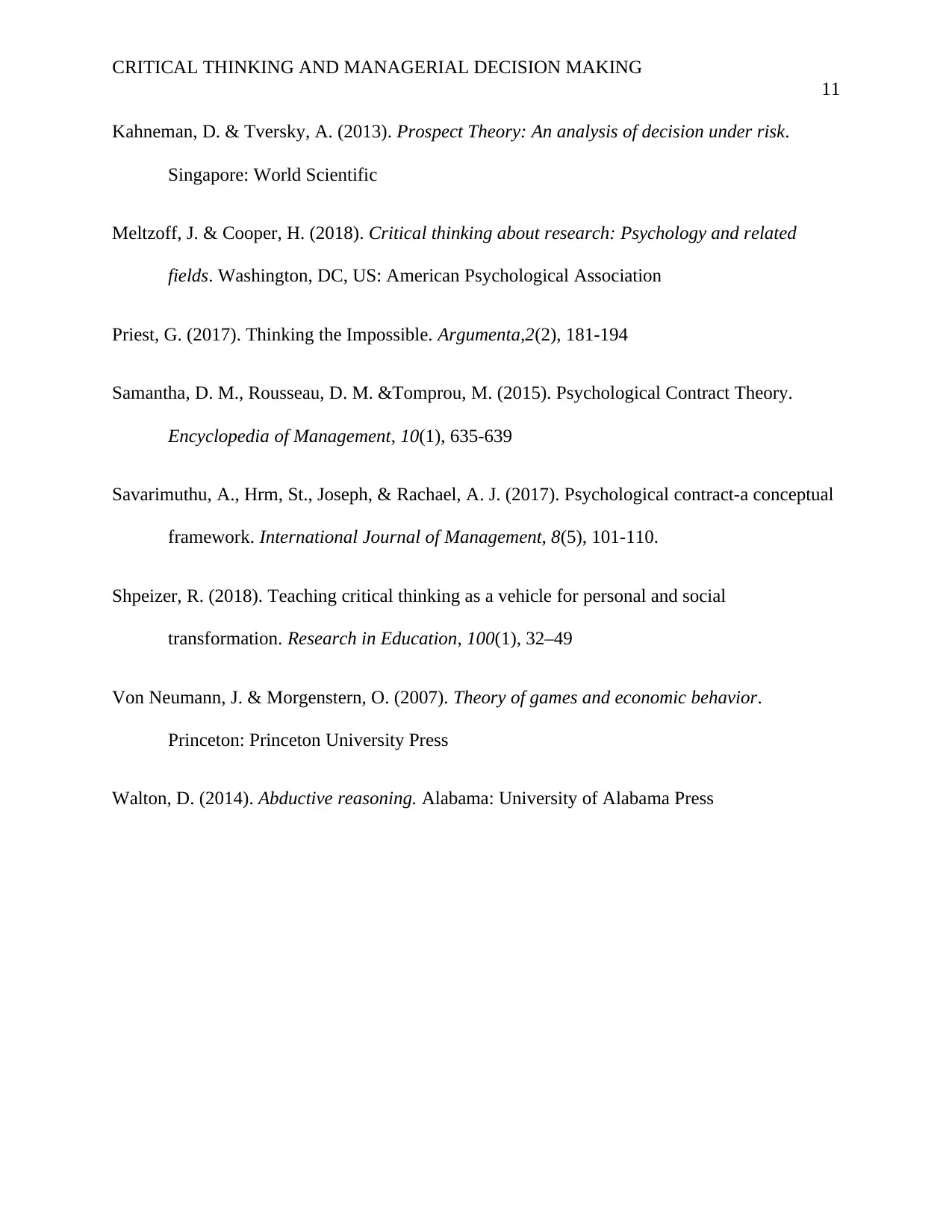
CRITICAL THINKING AND MANAGERIAL DECISION MAKING
11
Kahneman, D. & Tversky, A. (2013). Prospect Theory: An analysis of decision under risk.
Singapore: World Scientific
Meltzoff, J. & Cooper, H. (2018). Critical thinking about research: Psychology and related
fields. Washington, DC, US: American Psychological Association
Priest, G. (2017). Thinking the Impossible. Argumenta,2(2), 181-194
Samantha, D. M., Rousseau, D. M. &Tomprou, M. (2015). Psychological Contract Theory.
Encyclopedia of Management, 10(1), 635-639
Savarimuthu, A., Hrm, St., Joseph, & Rachael, A. J. (2017). Psychological contract-a conceptual
framework. International Journal of Management, 8(5), 101-110.
Shpeizer, R. (2018). Teaching critical thinking as a vehicle for personal and social
transformation. Research in Education, 100(1), 32–49
Von Neumann, J. & Morgenstern, O. (2007). Theory of games and economic behavior.
Princeton: Princeton University Press
Walton, D. (2014). Abductive reasoning. Alabama: University of Alabama Press
11
Kahneman, D. & Tversky, A. (2013). Prospect Theory: An analysis of decision under risk.
Singapore: World Scientific
Meltzoff, J. & Cooper, H. (2018). Critical thinking about research: Psychology and related
fields. Washington, DC, US: American Psychological Association
Priest, G. (2017). Thinking the Impossible. Argumenta,2(2), 181-194
Samantha, D. M., Rousseau, D. M. &Tomprou, M. (2015). Psychological Contract Theory.
Encyclopedia of Management, 10(1), 635-639
Savarimuthu, A., Hrm, St., Joseph, & Rachael, A. J. (2017). Psychological contract-a conceptual
framework. International Journal of Management, 8(5), 101-110.
Shpeizer, R. (2018). Teaching critical thinking as a vehicle for personal and social
transformation. Research in Education, 100(1), 32–49
Von Neumann, J. & Morgenstern, O. (2007). Theory of games and economic behavior.
Princeton: Princeton University Press
Walton, D. (2014). Abductive reasoning. Alabama: University of Alabama Press
1 out of 11
Related Documents
Your All-in-One AI-Powered Toolkit for Academic Success.
+13062052269
info@desklib.com
Available 24*7 on WhatsApp / Email
![[object Object]](/_next/static/media/star-bottom.7253800d.svg)
Unlock your academic potential
© 2024 | Zucol Services PVT LTD | All rights reserved.




